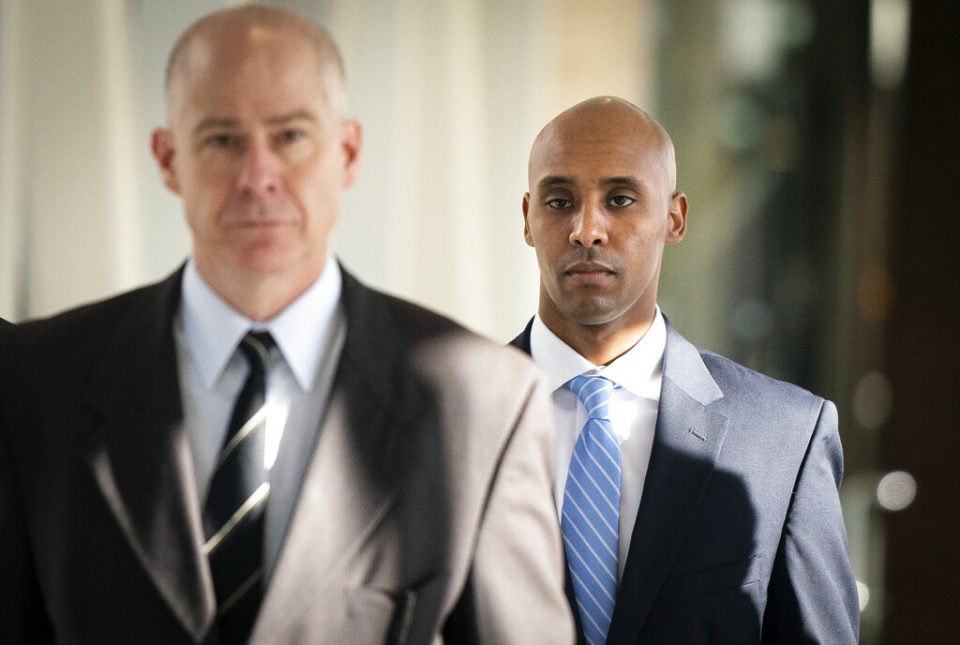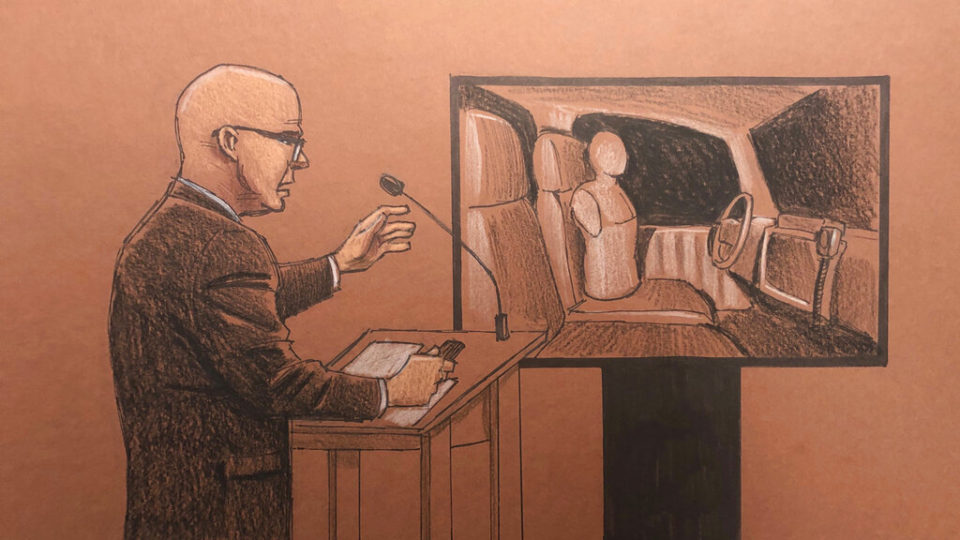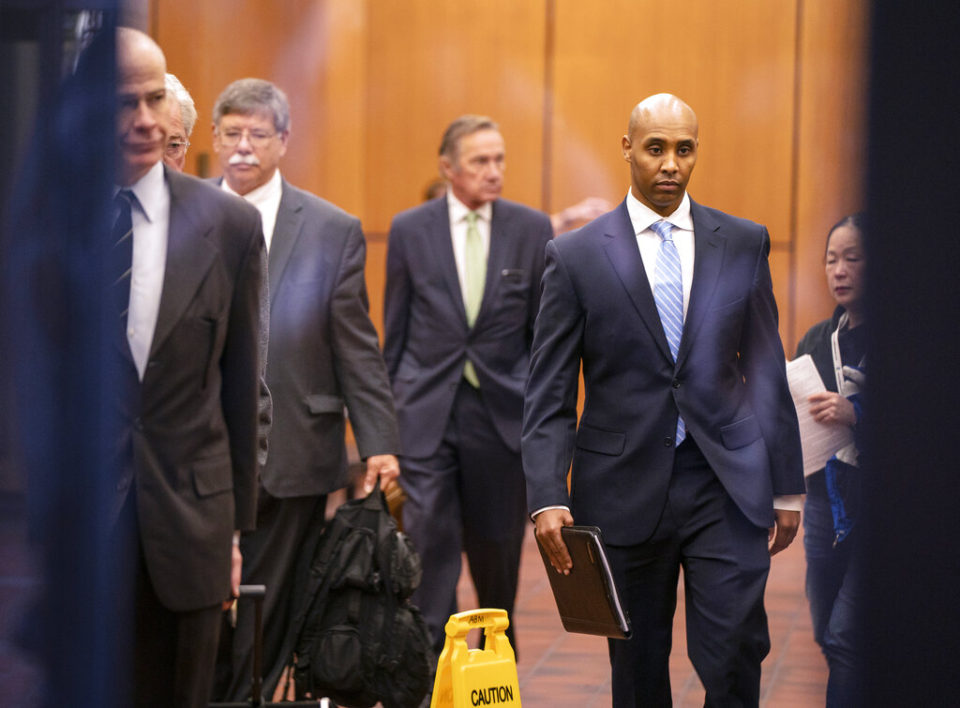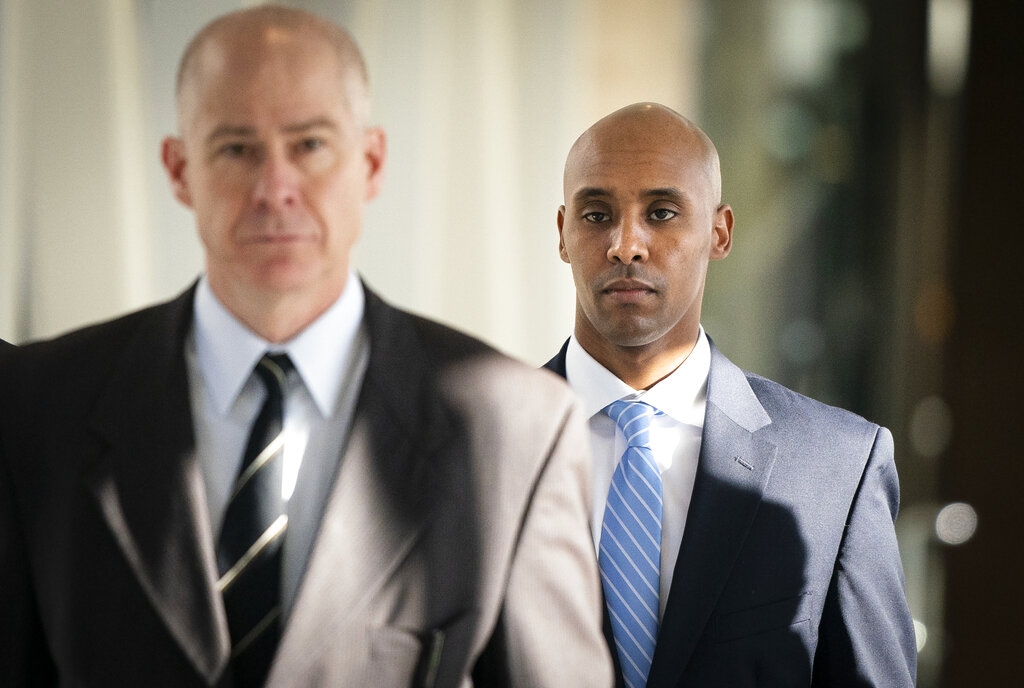
Former Minneapolis police officer Mohamed Noor walks through the skyway with his attorney Thomas Plunkett, left, on the way to court in Minneapolis on Friday, April 26, 2019. (Leila Navidi/Star Tribune via AP)
A Minneapolis police officer was convicted of murder Tuesday in the fatal shooting of an unarmed woman who approached his squad car minutes after calling 911 to report a possible rape behind her home.
Mohamed Noor was convicted of third-degree murder as well as manslaughter in the July 2017 death of Justine Ruszczyk Damond , a 40-year-old dual citizen of the U.S. and Australia. He wasn’t convicted of the most serious charge of intentional second-degree murder.
Jurors deliberated about five hours Monday and six on Tuesday before reaching a decision.

This courtroom sketch depicts defense attorney Thomas Plunkett, left, speaking during closing arguments in the trial of former Minneapolis police officer Mohamed Noor, Monday, April 29, 2019, in Minneapolis. Noor is charged in the fatal shooting of an unarmed Australian woman, Justine Ruszczyk Damond, in July 2017 after she called 911 to report a possible sexual assault behind her home. (Cedric Hohnstadt via AP)
Noor and his partner were rolling down the alley behind Damond’s home and checking out the 911 call just before the shooting. Noor testified that a loud bang on the squad car scared his partner and that he saw a woman raising her arm appear at his partner’s window. He said he fired to protect his partner’s life.
Prosecutors attacked Noor for shooting without seeing a weapon or Damond’s hands. They also questioned whether the loud bang was real. Neither Noor nor his partner, Matthew Harrity, mentioned it to investigators at the scene, with Harrity first mentioning it three days later in an interview with state investigators. Noor refused to talk to investigators.
The death of Damond, a life coach who was engaged to be married a month after the shooting, sparked outrage in both the U.S. and Australia. It also cost Minneapolis’ police chief her job and contributed to the electoral defeat of the city’s mayor a few months later.
Damond was white. Noor, 33, is a Somali American who became a police officer with a mid-career switch from jobs in the business world. He testified that he became a police officer because he “wanted to serve,” and his hiring two years before the shooting was celebrated by Minneapolis leaders eager for a more diversified police force in a city with a large population of Somali immigrants.
He was fired after being charged.

Former Minneapolis police officer Mohamed Noor walks through the elevator lobby of the Hennepin County Government Center with his legal team in Minneapolis on Friday, April 26, 2019. (Leila Navidi/Star Tribune via AP)
Neither officer had a body camera running when Damond was shot, something Harrity blamed on what he called a vague policy that didn’t require it. Both men switched on their cameras in time to capture the aftermath, which included their attempts to save Damond with CPR. But Noor’s bullet hit her in a key abdominal artery, and a medical examiner testified she lost so much blood so quickly that even faster medical care might not have saved her.
Prosecutors sought to raise questions about the way police and state investigators handled the aftermath. They played excerpts from body cameras worn by responding officers that revealed many officers turning them on and off at will; one officer could be heard on his camera at one point telling Noor to “keep your mouth shut until you have to say anything to anybody.” They also highlighted the lack of forensic evidence proving Damond touched the squad car.
But the case still came down to jurors’ assessment of whether Noor was justified in shooting, and they had only the officers’ testimony for a picture of the key moments. During his closing argument Monday, defense attorney Thomas Plunkett told jurors all that mattered was the “precise moment” in which Noor fired his gun and that they needed to consider whether Noor acted as a reasonable officer would act in the same circumstances. Prosecutor Amy Sweasy argued the shooting was not justified.
In his only public statement about the shooting, Noor testified that after he heard the loud noise, he saw fear in Harrity’s eyes and heard his partner yell, “Oh Jesus!” as he went for his weapon. Noor said Harrity was having difficulty pulling his gun from his holster. Noor said he then saw a woman in a pink shirt with blond hair appear at Harrity’s window and raise her right arm.
“I fired one shot,” he said, later adding: “My intent was to stop the threat and save my partner’s life.”
Harrity was pressed by prosecutors about why he didn’t fire. He said he hadn’t evaluated whether there was a threat by the time Noor fired. When Sweasy asked Harrity whether it would have been premature for him to use deadly force, he said: “Yes, with what I had.”
Both officers testified of their trust and high regard for each other. Both cried at points during their testimony.
The jury included 10 men and two women. Six of the jurors, including the two women, are people of color.
If convicted, the presumptive sentences vary from four years for the manslaughter charge to 12½ years for third-degree murder to 25½ years for second-degree murder.

